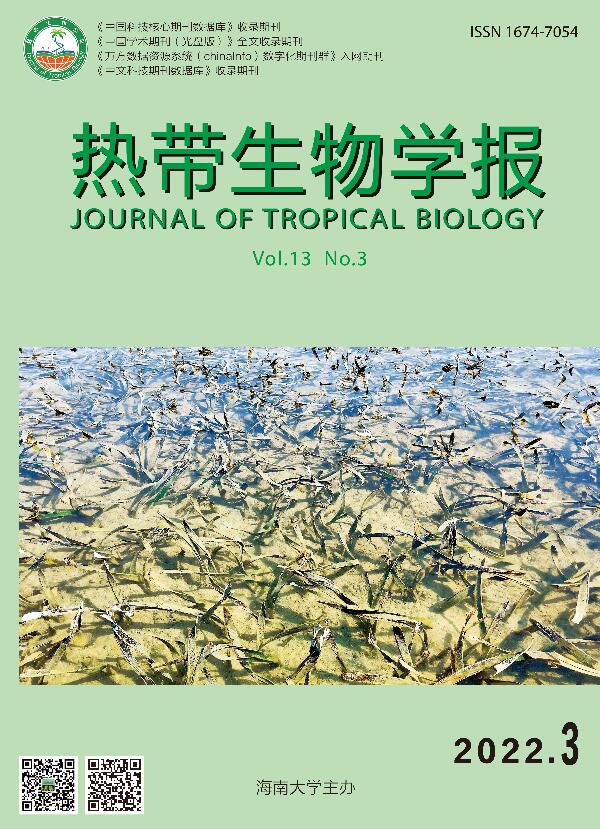-
文昌鸡是一种肉用型的地方优良品种,因其原产地为海南省文昌市而得名[1],具有觅食能力强、耐粗饲、耐热、早熟等特点[2],皮薄滑爽,肉质肥美,是海南四大名菜之一,深受广大生产者和消费者欢迎。目前,文昌鸡存在腹脂过度沉积的问题,腹脂沉积过多会降低鸡的屠宰率和饲料转化率[3],因此,降低文昌鸡腹脂过度沉积是其在育种过程中需要解决的问题。脂肪是鸡体重要组成成分之一,是家禽能量的来源,在家禽生命的维持、生长和生产中都起着十分重要的作用[4]。鸡体内脂肪沉积部位主要在皮下、腹部和肌肉中[4],其中腹部是脂肪沉积的主要部位[5]。目前,关于文昌鸡体脂分布及沉积规律的研究还未见报道,因此,本研究以文昌鸡为研究对象,对其体脂分布及沉积规律进行初步的研究,为低腹脂文昌鸡的育种提供理论参考。
-
(1)试验动物:200只健康文昌母鸡,由海南省文昌市潭牛文昌鸡股份有限公司提供,参照《DB46/T44—2011,文昌鸡饲养管理技术规程》[6],实施规范的饲养管理,执行正常的免疫程序,105日龄开始笼养育肥。(2)试验仪器:游标卡尺(型号为TM004),购自南通市锦诺工量刃具有限公司;恒温水浴振荡器(型号为SHA-B),购自常州亿通分析仪器制造有限公司;酶标仪(型号为Multiskan FC),北京海天友诚科技有限公司;脂肪提取仪(型号为 SOX606),购自上海力晶科学仪器有限公司。
-
选取27、53、79、105日龄各20只,育肥2、4、6、8周各30只文昌母鸡,禁食12 h后称量活体质量。屠宰后迅速将腹脂垫及肌胃周围脂剥离称重,并将肝脏、胸肌和腿肌逐一剥离置于−20 ℃冰箱储存。
-
腹脂包括腹脂垫和肌胃周围脂肪。
-
从文昌鸡尾根部切线起沿第一条切线将两侧的皮剥掉。游标卡尺使用时应轻轻地将其卡住,切记不可用力挤压,避免使其压坏。调整好后读出游标卡尺上的数值,并将其记录,即为皮下脂肪厚度。
-
粗脂肪含量的测定采用索氏抽提法,按照《GB5009·6—2003》[7]进行。
-
利用SAS 9.4软件对试验数据进行统计分析,结果均用“平均值±标准差”表示, P<0.05 为差异显著。
-
文昌鸡活体质量随着饲养日龄的增加而增长,育肥后显著增长(P<0.05);文昌鸡腹脂率随着饲养日龄的增加呈上升趋势,育肥后其腹脂率显著上升(P<0.05);但在育肥期间,腹脂率无显著性变化(P>0.05)。
-
文昌鸡皮下脂肪厚度随着饲养日龄的增加而显著增长(P<0.05)。27日龄到79日龄,皮下脂肪厚度显著性增加(P<0.05),之后显著下降(P<0.05),育肥后又呈上升趋势;在笼养育肥期间皮下脂肪厚度无显著性变化(P >0.05)。
周龄 活体质量/kg 腹脂率/% 皮下脂肪厚度/mm 27日龄 0.186 3±0.02381F 0.643 4±0.4715D 2.579±0.8455D 53日龄 0.627 0±0.1224E 1.832±0.5464C 6.021±1.383C 79日龄 1.032±0.1627D 2.811±0.8988B 9.433±2.832A 105日龄 1.047±0.1599D 3.375±1.5285B 7.314±1.804B 育肥2周龄 1.355±0.09455C 4.038±0.8126A 9.660±1.789A 育肥4周龄 1.411±0.1072BC 4.256±1.174A 9.231±1.823A 育肥6周龄 1.485±0.1965AB 4.404±1.214A 9.709±2.100A 育肥8周龄 1.508±0.1455A 4.601±0.9905A 10.25±1.736A 注:同列数值不同大写字母表示差异显著(P<0.05),相同大写字母则差异不显著(P >0.05),下同。 -
文昌鸡胸肌和腿肌肌内脂肪含量均随着饲养日龄的增加而增长,并在育肥第六周时达到最高值。
-
文昌鸡肝脏内粗脂肪含量呈波浪式变化,105日龄时达到最高值,之后显著下降(P<0.05),但在育肥4周龄后又随着日龄的增长而增长。
周龄 胸肌肌内
脂肪含量/%腿肌肌内
脂肪含量/%肝脏脂肪
含量/%53日龄 1.47±0.534E 3.34±1.14E 10.38±1.947CD 79日龄 2.54±0.801CD 5.03±1.31D 11.74±7.587BCD 105日龄 2.33±0.453D 6.32±1.29C 18.14±6.885A 育肥2周龄 2.93±0.560BC 6.87±0.892BC 13.04±4.906BC 育肥4周龄 2.93±0.581BC 7.85±1.22AB 9.691±1.382D 育肥6周龄 3.88±1.29A 8.56±1.29A 12.12±3.700BCD 育肥8周龄 3.35±0.636B 7 .96±2.21AB 13.41±3.290B -
本研究结果显示文昌鸡脂肪在肌肉、腹部、皮下脂肪间的沉积规律不明显,这与陈继兰[8]的研究报道一致。可能是因为不同组织部位的脂肪形成与分解机制和时间存在差异,所以各组织间脂肪沉积规律尚不明确[9]。
本研究测得的腹脂率与皮下厚度变化没有一致性规律。杨凌云等[10]结果显示,腹脂和皮下脂肪的沉积规律不同。本研究结果显示,文昌鸡腹脂率随着日龄的增加而增加,这和《中国畜禽遗传资源志:家禽志》[11]中各品种的测定结果一致。
有研究表明文昌鸡肌内脂肪含量随周龄的变化呈现波浪式变化[12],这与本研究结果一致,肌内脂肪在育肥期6周龄达到最高峰,并在育肥8周龄时下降。唐辉等[13]在文昌鸡肉质特性的研究中的结果提到文昌鸡腿肌肌内脂肪含量显著高于胸肌肌内脂肪含量。付睿琦[14]在北京油鸡中的研究中结果也显示腿肌中的脂肪含量显著高于在胸肌中的脂肪含量。上述2个研究结果与本研究结论一致,本研究发现在相同日龄时期腿肌中的脂肪含量高于在胸肌中的脂肪含量。肌内脂肪含量取决于肌肉内脂肪细胞数量和脂肪的合成能力[15],育肥期文昌鸡腿肌中肌内脂肪含量约为胸肌中的2~3倍,可能是由于胸肌和腿肌内脂肪细胞数目和生长发育状况不同而导致的差异。
本研究结果中肝脏粗脂肪含量在105日龄时达到高峰,在笼养育肥之后出现下降趋势。肝脏中脂肪合成量会影响脂肪组织中脂肪的沉积量[15],肝脏合成脂肪酸后,转移到脂肪组织中沉积[16],育肥期是脂肪快速沉积的时期,在育肥之前肝脏内需合成大量的脂肪,为后续脂肪沉积做准备,故肝脏粗脂肪含量在105日龄时达到最高。
Distribution and deposition of body fat in Wenchang chicken
doi: 10.15886/j.cnki.rdswxb.2022.03.013
- Received Date: 2021-12-29
- Accepted Date: 2022-05-06
- Rev Recd Date: 2022-03-01
- Available Online: 2022-05-16
- Publish Date: 2022-05-23
-
Key words:
- Wenchang chicken /
- body fat distribution /
- deposition law
Abstract: Wenchang chicken is a broiler breed in Hainan, and has strong adaptability, heat resistance, and good meat quality. At present, Wenchang chickens have the problems of low feed conversion rate and high abdominal fat rate, which restrict the development of Wenchang chicken industry. An attempt was made to analyze the body fat distribution and deposition pattern of Wenchang chickens, which might provide some reference for the breeding of Wenchang chickens. Wenchang chickens at 27, 53, 79, 105 days of age and at 2, 4, 6, 8 weeks of fattening, respectively, were slaughtered, and their abdominal fat percentage, subcutaneous fat thickness, intramuscular fat content and liver crude fat content were determined. The results showed that the fat deposition in the abdomen, subcutaneous tissue and muscle were significantly increased with age (P<0.05). The fat content in the breast muscle was the highest at 6 weeks of fattening, similar to that in the leg muscle. The crude fat content in the liver had a wavy change, and was the highest at 105 days of age.
| Citation: | ZHANG Ying, WANG Ying, WU Hongfen, WANG Liuhao, WU Kebang, NA Wei. Distribution and deposition of body fat in Wenchang chicken[J]. Journal of Tropical Biology, 2022, 13(3): 297-299. doi: 10.15886/j.cnki.rdswxb.2022.03.013 |






 DownLoad:
DownLoad: